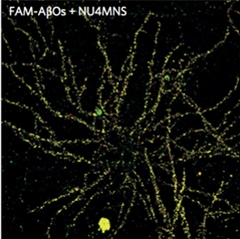Antibody Probe Seeks Aβ Oligomers in MRI
Quick Links
Aβ oligomers are widely seen as the cause of synaptic damage and cognitive decline in Alzheimer’s disease. Researchers want to be able to detect these peptides in vivo to better diagnose and track the progression of AD. In an effort to develop a suitable probe, scientists led by William Klein and Vinayak Dravid, Northwestern University, Evanston, Illinois, have linked an oligomer-specific antibody to magnetic nanostructures traceable through magnetic resonance imaging (MRI). In the December 22 Nature Nanotechnology, they report MRI data of Aβ oligomers in mouse models of AD.
The scientists previously presented some of this work at the 2012 Society for Neuroscience annual meeting (see Oct 2012 conference story). They linked the oligomer-specific antibody NU4 to a magnetic nanoparticle (see Lambert et al., 2009). This NU4MNS probe bound to Aβ oligomers in solution and to those added to cultured rat hippocampal cells (see image below). It generated MRI signals in postmortem brain slices from people who had AD and distinguished them from control tissue. In human sections of frontal cortex, fluorescently labeled NU4MNS bound diffuse plaque-like structures almost as strongly as fluorescently tagged NU4, the scientists reported at the time.

Oligomer-bound:
NU4MNS (red) co-localized with Aβ oligomers (green) added to hippocampal cells. [Image courtesy of Nature Nanotechnology, Viola et al.]
In the current study, first author Kirsten Viola and colleagues extended those findings by probing for the tracer in mice using MRI. The researchers placed droplets of NU4MNS inside the noses of 8-month-old transgenic 5xFAD mice and of age-matched wild-type mice. Allowing four hours for the antibody to distribute and bind in the brain, the scientists scanned the animals in a micro MRI machine. The resulting images suggested a signal in the hippocampus and cortex of the 5xFAD, but not wild-type, mice. Four days later, some, but not all, of the antibody had cleared from the transgenic mouse brains. None of the mice developed infections or reacted adversely to the probe, the scientists reported.
Other AD researchers commented to Alzforum that the oligomer signal in the 5xFAD mice appeared almost indistinguishable from that in the wild-type mice, and lacked anatomical specificity. If the antibody worked as a tracer, they would expect a stronger signal in the transgenic animals. The problem could have to do with the density of oligomers throughout the brain, they proposed. A good tracer for MRI or positron emission tomography gets into the central nervous system, binds a target, and the rest diffuses out rapidly for the best signal-to-noise ratio. Dravid said that though it appears subtle, this signal can be detected and quantified by computer analysis. He uses these types of antibody-linked magnetic nanostructures to identify tumors and other cancers. Dravid said that the signal from brains of AD transgenic mice is more diffuse than one would see in a tumor because Alzheimer’s pathology is not localized to one region of the brain.
The researchers plan to do further MRI testing in mice at different stages of disease. If successful, they want to move on to primate studies, said Dravid. Eventually, they envision patients using a nasal spray to transfer this antibody probe into the brain, and after a couple of hours undergoing MRI scanning. Other scientists were skeptical that a nasal spray would work in people, since even in mice, most labeling stays in olfactory nerve cells, and little reaches the brain. Labeling a high concentration of Aβ oligomers with small amounts of antibody seems unfeasible, they said. Klein said that his group is developing a PET biomarker based on this antibody, as well.—Gwyneth Dickey Zakaib
References
News Citations
Research Models Citations
Paper Citations
- Lambert MP, Velasco PT, Viola KL, Klein WL. Targeting generation of antibodies specific to conformational epitopes of amyloid beta-derived neurotoxins. CNS Neurol Disord Drug Targets. 2009 Mar;8(1):65-81. PubMed.
Further Reading
Papers
- Walton JH, Berry RS, Despa F. Amyloid oligomer formation probed by water proton magnetic resonance spectroscopy. Biophys J. 2011 May 4;100(9):2302-8. PubMed.
- Xiao C, Davis FJ, Chauhan BC, Viola KL, Lacor PN, Velasco PT, Klein WL, Chauhan NB. Brain Transit and Ameliorative Effects of Intranasally Delivered Anti-Amyloid-β Oligomer Antibody in 5XFAD Mice. J Alzheimers Dis. 2013 Jan 1;35(4):777-88. PubMed.
- De M, Chou SS, Joshi HM, Dravid VP. Hybrid magnetic nanostructures (MNS) for magnetic resonance imaging applications. Adv Drug Deliv Rev. 2011 Nov;63(14-15):1282-99. Epub 2011 Aug 6 PubMed.
- Liu S, Jia B, Qiao R, Yang Z, Yu Z, Liu Z, Liu K, Shi J, Ouyang H, Wang F, Gao M. A novel type of dual-modality molecular probe for MR and nuclear imaging of tumor: preparation, characterization and in vivo application. Mol Pharm. 2009 Jul-Aug;6(4):1074-82. PubMed.
Primary Papers
- Viola KL, Sbarboro J, Sureka R, De M, Bicca MA, Wang J, Vasavada S, Satpathy S, Wu S, Joshi H, Velasco PT, MacRenaris K, Waters EA, Lu C, Phan J, Lacor P, Prasad P, Dravid VP, Klein WL. Towards non-invasive diagnostic imaging of early-stage Alzheimer's disease. Nat Nanotechnol. 2015 Jan;10(1):91-8. Epub 2014 Dec 22 PubMed.
Annotate
To make an annotation you must Login or Register.

Comments
No Available Comments
Make a Comment
To make a comment you must login or register.